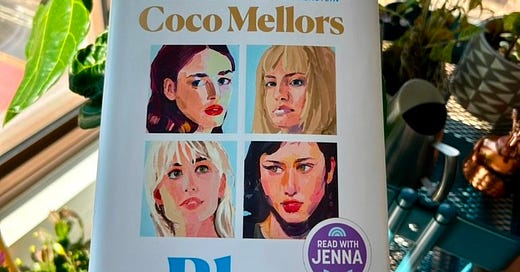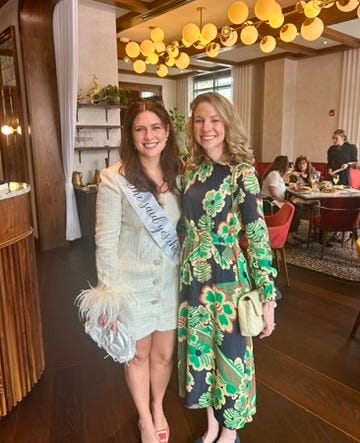Two of the stories I’ve read and watched this past month, that I’ve continued to ruminate on, center around sister relationships.
Last month I read Blue Sisters by Coco Mellors. I lingered in this book for weeks, underlining dozens of sentences and passages that jumped out at me. Interesting turns of phrase and metaphors; unique characterizations; hard-won wisdom and truths that the characters come to learn by the end. I love Mellors’ writing style, which quite simply sparkles on every page, and I can’t wait to pick up her first novel after reading Blue Sisters.
This novel has some Little Women vibes baked into it: it centers around four sisters and from the first chapter, we learn that one of the sisters, Nicky, died the previous year. This is a departure from the sequence of events in Little Women, as Beth dies later in the narrative, and though Nicky never shows up in real-time in the novel, she is very much a character who appears through memory, flashbacks, and the mark she left on her siblings. Her absence and its impact on her sisters is part of the glue that binds them together as they grapple with their identities in her absence and the guilt of not being able to save her. In the tradition of Little Women, the Blue sisters also come from relative poverty, their family of six growing up in a tiny Manhattan apartment, with a father who is also largely absent.
Woven in with the sister dynamics, is the major theme of addiction, which impacts each member of the Blue family on a different level. Avery, the eldest, is a former heroin addict who got clean with the help of AA and is now a high-strung lawyer a decade sober. All of the sisters have memories of their father’s violent, alcohol-fueled episodes from their childhood. And we learn from the first chapter just how much youngest Lucky is swept up in the culture of drinking and partying, though she isn’t yet aware of the potential dangers of her behavior. Only middle-sibling Bonnie has never experimented with drugs, but she is singularly scarred by the circumstances of Nicky’s death (I am keeping this vague, so as not to include spoilers).
Amid January’s snowstorms, I binged both seasons of Bad Sisters in a few weeks. The series is a dark comedy following five sisters in their clumsy attempts to cover up the murder of their toxic brother-in-law. Some trigger warnings going into this show: there is a fair amount of domestic violence as we learn that JP, the dead brother-in-law, is a particular type of asshole. I understand these scenes of his cruelty are necessary to show the sisters’ rationale for murder, but they can be difficult to watch.
In addition to the gorgeous setting of the show – shot in and around Dublin and nearby Howth – and the Irish accents, what I loved most about Bad Sisters was its sincere and vulnerable depiction of sisterhood. As the sisters get deeper into their schemes to cover up the murder, tensions grow. Particularly in season two, after we’ve gotten to know the Garvey sisters as individuals, Bad Sisters convincingly shows the particular ability of sisters to make each other tick. The Garvey girls innately know the words that will cut deep and how to wield them. They argue and hurt each other; make mistakes and rash decisions — but after every misunderstanding and injured feeling, they always find their way back to fierce familial loyalty. Youngest sister Becca knows exactly how to hurt eldest Eva, telling her to “stop mothering me because you don’t have anyone else to mother,” cutting right to Eva’s wound of never having had her own kids. Of course, Becca doesn’t mean this, and she soon regrets it, but she does it to shift the balance of power, to put Eva in her place when she is being too pushy.
In Bad Sisters, we’re continually reminded how different the Garvey women are. Although they share a family history, they have all chosen or fallen into very different lives and are at various points in their life trajectories due to the ten plus years between them. The same dynamic struck me in Blue Sisters. From high-achieving, type-A eldest Avery, to grounded, athletic middle-sister Bonnie, to artsy, model Lucky, the personalities and motivations of the sisters vary greatly, yet they are connected by the strings of their shared childhood and uniquely understand each other because of this.
I love novels that center around complex mother-daughter relationships (of which there are a ton out there) as well as those that explore female friendships. It struck me that sisterhood includes elements of both relationships. Sisters understand each others’ childhood histories and traumas the way mothers do their daughters, yet sisters are peers with an ever-shifting power dynamic the way close friends are. Sisters aren’t something I read about quite as often, but I found the way Bad Sisters and Blue Sisters portrayed sisterhood — its beautiful and ugly parts in equal measure — to be fascinating and honest. Despite the extreme circumstances the women in both stories land in and the dramatic choices they make, the primal bonds of sisterhood ground them — and we, as readers, relate to them because of this.
And now, I am off to a Florida bachelorette party for my own sister — who I’m lucky to call a soulmate and best friend. If you have a favorite work of fiction that explores sisterhood, let me know in the comments.
In other news, I’ll be reading a short story on March 15th at the 804 Lit Salon, an awesome reading series founded by my friends, authors Andrew Bertaina and Lauren Woods. I’d love to see you if you’re local. Happy reading and writing, everyone! Until next month.







